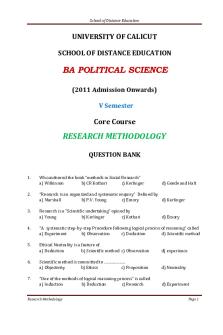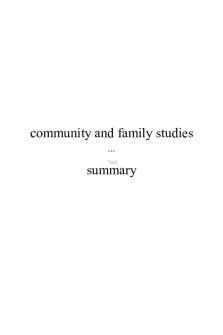Lecture 1 - Doctrinal Legal Research Methodology PDF

| Title | Lecture 1 - Doctrinal Legal Research Methodology |
|---|---|
| Course | Research Methods |
| Institution | University of Stirling |
| Pages | 4 |
| File Size | 102.7 KB |
| File Type | |
| Total Downloads | 91 |
| Total Views | 152 |
Summary
Download Lecture 1 - Doctrinal Legal Research Methodology PDF
Description
Legal Analysis I -
What is ‘analysis’? How does it connect to legal research? How does it connect to legal writing? How do we analyse a case?
Where does analysis fit in with legal writing? - Legal analysis is closely connected to legal research and to legal writing There are different methods expressed by writers, but quite similar: CLEO: Claim, Law, Evaluate, Outcome IRAC: Introduction, Rule, Application/Analysis, Conclusion IPAC: Introduction, Principle, Application/Analysis, Conclusion We are able to say what the law is but can we discuss arguments for and against it? Poor writing practices undermine good research Examples of these include: - Informal writing e.g. use of contractions – don’t, haven’t, won’t etc - Poor use of paragraphs (if you don’t separate them out, could be very confusing) - Not demonstrating an awareness of how to distinguish between your views and other views - Inadequate or inappropriate use of sources (i.e. quality and relevance)Primary and secondary sources! - Excessive use of the same sources (except where inevitable e.g. core statutory provisions – but should not exclude variety of cases and scholarly views) - Excessive reliance on auto spell check (doesn’t address syntax issues) Writing and research- more tips on what to avoid -
Excessive descriptions (at the expense of analysis). If you don’t spend time analysing and just talk about what the law is, then you will always get lower marks Copying and pasting from online sources (can cause formatting issues as well) Copying and pasting Long-winded sentences Use of confusing or no subheadings Plagiarism (which is never an issue when students who ensure proper referencing
What is analysis at Honours Level? (SCQF Level 10) -
Critically identify, define, conceptualise and analyse complex/professional problems and issues. Being critical is not a negative word, you can look at something with a
-
-
critical eye and you are testing it to see whether the law is fair, is it compliant with human rights? Offer professional insights, interpretation and solutions to problems and issues. These insights come from weighing up competing arguments for and against a particular law. Demonstrate some originality and creativity in dealing with professional issues Critically review and consolidate knowledge, skills, practices and thinking in a subject, discipline/sector Make judgements where date/information is limited or comes from a range of sources
Case Study: lower levels of analysis (1st and 2nd year) Sharp v Thomson 1997 S.C. (H.L.) 66 What is the case about and why did the court make the decision that it did? - Anatomy of the case: Court, citation, date, parties, counsel, judgement - You can use principles of judicial precedent to ‘rank’ the case - Finding the ration decidendi and obiter dicta in the judgement - Checking for cases it has overruled, distinguished, followed Higher level of analysis: 1. Critically examine the judgement: what’s the effect on the law of it? Has it pushed the law in a good direction or a bad direction, why is it good why is it bad? How? Research a wide range of sources in which law reform bodies, academics, lawyers and others have commented on or critically reviewed the decision and judgement. For example: -
-
Scottish Law Commission Discussion Papers and Reports (really good sources for amazing summaries on what the law is, also discussion on reform- what is lacking in the law, what do stakeholders who are involved in it feel about it etc) Journal Articles Considering comparative analysis
2. Consider effect on the law of the judgement 3. Consider if it is actually correct 4. Consider if action needs to be taken to reform the law as a result of the case If you were to search up the case on westlaw, there would be over 100 articles discussing it! Mainly short pieces but some longer. Some give differed perspectives. We need to be able to evaluate research to get it into some kind of order
So, what happened in this case? - In the case of Sharp v Thomson, there was a wide consultation on whether the law had to be changed by statute because of the confusion raised by the judgement but in the end, another case came along and the confusion was put to rest by the House of Lords in Burnett’s Trustee v Grainger [2004] UKHL 8. The matter was clarified in this case - There was a lot of discussion about whether there had to be a change in the law from the sharp v Thomson case “You essay needs more analysis”- What does this mean? - You need to do more reading, engage in more discussions. Don’t focus on the WHAT focus on the WHY Critical Analysis The purpose of essays at Honours Level: to access the extent and depth of your knowledge, including your abilities at legal research, the construction of argument (the argument is based on the research you’ve done), and the effective presentation of your ideas. You therefore have to argue. To argue, you have to have a point, and you need to examine arguments for or against your point made by others. It is not enough to merely cite case law or literature. You have to discuss it Focus -
When doing essays you need to explain what your focus is Avoid the inclusion of irrelevant material. You need to decide what is relevant or irrelevant The reader is very likely to get distracted by unfocussed discussion of history, concepts, facts and the like
Quotes -
Keep your quotes short and to the point Long quotations are not a good way to write a law paper A good general rule is that you should have no more than 10 continuous lines if intended single-spaced quotation in your text at any one time
Footnotes -
-
One of the most important things to remember is that all statements must be supported by evidence or authority. This is an absolute must in legal writing You should never assume that your reader will read your footnotes so do not put any important points in the footnotes. Use footnotes for authority and to elaborate, not to make arguments Footnotes are not included in the final wordcount
Always comply with the OSCOLA style guide and to include a bibliography!
Process: Recording your information -
Be organised Keep notes of where sources have come from Don’t use a source in your dissertation if you have not recorded where it came from University’s Quality Handbook states: “Dissertations must carry a signed pro-forma statement that the student understands the nature of academic misconduct, is aware of the University’s policy and confirms that what is submitted is all their own work”
Process: composing a literature review -
CONTEXT: the review places your research questions withing the wider academic context – what do others have to say about it? YOUR VIEW: reports your critical review of the relevant literature – some evaluation required of the merits of arguments; and YOUR ‘ADDED VALUE’: you state how you will add value to the field – what gap within that literature will your own research attempt to address
BAILII FINANCIAL TIMES NEWSPAPER HANSARD HEINONLINE HUDOC JSTOR JUSTICE SESSION CASE ARCHIVE KLUWER ARBITRATION LAW E-JOURNALS LAWS OF SCOTLAND ONLINE- STAIR MEMORIAL ENCYLOPAEDIA LEGISLATION.GOV.UK LEXIS LIBRARY OIL, GAS AND ENERGY LAW OXFORD JOURNALS ONLINE PAULGRAVE MCMILLAN JOURNALS SCOTTISH LEGAL HISTORY STORRE WESTLAW...
Similar Free PDFs

Doctrinal Legal Research Final
- 17 Pages

WHAT IS Legal Research Methodology
- 16 Pages

Legal Methodology
- 68 Pages

research methodology
- 1 Pages

RESEARCH METHODOLOGY
- 69 Pages

Research Methodology and IPR
- 2 Pages

MCQ ps research methodology
- 18 Pages

CHAPTER III RESEARCH METHODOLOGY
- 6 Pages

Research Methodology MCQS
- 6 Pages

CHAPTER 2 RESEARCH METHODOLOGY
- 6 Pages

Research Methodology MCQ
- 15 Pages

Research methodology assignment
- 10 Pages

Questionnaire Research Methodology
- 10 Pages

CAFS research methodology
- 13 Pages
Popular Institutions
- Tinajero National High School - Annex
- Politeknik Caltex Riau
- Yokohama City University
- SGT University
- University of Al-Qadisiyah
- Divine Word College of Vigan
- Techniek College Rotterdam
- Universidade de Santiago
- Universiti Teknologi MARA Cawangan Johor Kampus Pasir Gudang
- Poltekkes Kemenkes Yogyakarta
- Baguio City National High School
- Colegio san marcos
- preparatoria uno
- Centro de Bachillerato Tecnológico Industrial y de Servicios No. 107
- Dalian Maritime University
- Quang Trung Secondary School
- Colegio Tecnológico en Informática
- Corporación Regional de Educación Superior
- Grupo CEDVA
- Dar Al Uloom University
- Centro de Estudios Preuniversitarios de la Universidad Nacional de Ingeniería
- 上智大学
- Aakash International School, Nuna Majara
- San Felipe Neri Catholic School
- Kang Chiao International School - New Taipei City
- Misamis Occidental National High School
- Institución Educativa Escuela Normal Juan Ladrilleros
- Kolehiyo ng Pantukan
- Batanes State College
- Instituto Continental
- Sekolah Menengah Kejuruan Kesehatan Kaltara (Tarakan)
- Colegio de La Inmaculada Concepcion - Cebu

